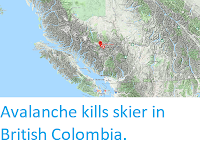Natural Resources Canada
reported a Magnitude 6.2 Earthquake at a depth of 5 km roughly 182 km off the west
coast of Vancouver Island, British Columbia, slightly after 7.35 pm local time
on Tuesday 24 December 2019 (slightly after 3.35 am on Wednesday 25 December, GMT).
This is a large quake, and was felt across much of southern British
Columbia and northwest Washington State, although there are no reports
of any damage or casualties, and no tsunami warning was issued.
The approximate location of the 24 December 2019 Vancouver Island Earthquake. USGS.
Vancouver Island is located on the western margin of the North American
Plate, close to the Challenger Trench, along which the Explorer and Juan
de Fuca Plate are being subducted. These are two remnant parts of the
ancient Farallon Plate, which formerly underlay part of the eastern
Pacific, and which has now been largely subducted beneath North America.
The Explorer an Juan de Fuca Plates pass under the North American Plate
as they sink into the Earth, but this is not a smooth process, with the
plates constantly sticking together then breaking apart as the tectonic
stresses build up.
The subduction of the Juan de Fuca Plate beneath North America. United States Geological Survey.
On this occasion the Earthquake occurred on the northern part of the Juan de Fuca Plate, close to the Juan de Fuca Ridge. The
Juan de Fuca ridge marks the extensional margin between the Juan de
Fuca Plate and the Pacific Plate. The Juan de Fuca Plate is thought to
be a remnant of an ancient plate known as the Farallon Plate, a once
vast plate now largely subducted beneath the North American Plate. There
are three remnants of this plate remaining off the west coast of the
US; the Juan de Fuca Plate, the Gorda Plate to the south and the
Explorer Plate to the north. The Juan de Fuca Ridge was once part of the
longer Farallon Ridge, which ran along the eastern margin of the
Farallon Ridge before it was fractured into three parts.
Spreading on the Juan de Fuca Ridge, and its relationship to the volcanoes of the North American west coast. Wikimedia Commons.
Witness reports can help geologists to understand the processes going on
in Earthquakes and the structures in the rocks that cause them. If you
felt this quake you can report it to Natural Resources Canada here.
See also...









